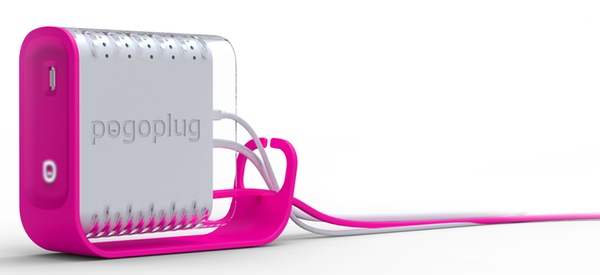
PogoPlug has gotten a fair bit of coverage here at CrunchGear, including a full review of the original PogoPlug device. A new version was recently released, with quite a bit more to offer, so an updated review is in order. The second generation PogoPlug supports up to four USB drives, offers gigabit Ethernet, has mobile clients for the major smartphones, and has a burgeoning independent developer community. That’s a lot for a $129 gadget!
Features:
- works with Linux, Mac and Windows computers, plus Android, Blackberry, and iPhone smartphones
- supports up to 4 USB drives, and recognizes NTFS, FAT32, HFS+, and ext2/ext3 partitions
- access and share files from anywhere, with no changes required in your firewall configuration
- create and share media slideshows with ease
- MSRP: $129
Pros:
- super easy to use: setup completes in less than a minute
- diminutive form factor
- extremely extensible
Cons:
- No display of free space on USB media
- All access goes through my.pogoplug.com.
- No wireless networking
Review
I’ve been using Dropbox for a couple months now to synchronize my files across several different computers. It works, but sometimes I just don’t want my data living on someone else’s servers. The PogoPlug solves that problem by allowing me to store my data on my physical hardware, and access it from anywhere using either a web-based interface, a WebDAV system that makes the PogoPlug look like a locally connected drive on my computer, or via a mobile phone. I can also store a lot more data on a PogoPlug for considerably less money than twelve months of Dropbox service.
I have two gripes with the PogoPlug, which should be addressed up front. They’re both pretty small, and do not in any way detract from my willingness to recommend this product to everyone. First, all remote access of my data takes place through the my.pogoplug.com URL. I believe them when they say “the data may be forwarded through our servers, but no copies are retained during this process”, but it still makes me a little uncomfortable. Also, it’s worth noting that when accessing your PogoPlug locally — that is, both you and the PogoPlug are on the same LAN — you talk to the PogoPlug directly, without going through pogoplug.com. Second, there is no obvious display of the capacity of the attached media, nor indication of how much space is free. It’s there in the Settings page, but not on the main screen’s sidebar. This usually won’t be a problem if you’re attaching current vintage hard drives, but if you plug in a USB flashdrive, you might have more interest in knowing how much space is free before you try to upload something.
The my.pogoplug.com website has had a modest update, to properly display the different media that may be attached to the unit. Navigating files and directories is as simple as it should be. Uploading and downloading files is problem-free. Creating slideshows from media is easy to do, and sharing those slideshows is simple, too!
One of the more surprising features of the new PogoPlug is its ability to transcode video files automatically. Upload a video to your PogoPlug, and within a couple moments it’ll have a small preview clip that you can play from your computer or iPhone. Then, while you wait, a complete mobile-friendly version of your video will be produced! This is not a fast process, since the PogoPlug hardware is not super-computer caliber. It took over eight hours to transcode a rip of George Romero’s classic Dawn of the Dead that I put onto the PogoPlug. But, once the transcode was finished, I was able to watch the zombie fun right on my iPhone while riding a city bus around town! I don’t know that this is a reason to buy the PogoPlug by itself, but it’s certainly a feature not commonly found in other NAS devices just yet.
Another interesting aspect of PogoPlug is that they don’t shy away from the fact that they use open source software under the hood. Many similar products don’t make any public mention of their use of open source software, let alone provide you root access to your device!
-bash-3.2# free
total used free shared buffers
Mem: 256012 20428 235584 0 0
Swap: 0 0 0
Total: 256012 20428 235584
-bash-3.2# df -h
Filesystem Size Used Available Use% Mounted on
/dev/mtdblock2 32.0M 11.6M 20.4M 36% /
none 125.0M 8.0k 125.0M 0% /tmp
-bash-3.2# uname -a
Linux Pogoplug 2.6.22.18 #44 Mon Aug 10 12:57:36 PDT 2009 armv5tejl unknown
-bash-3.2# head -2 /proc/cpuinfo
Processor : ARM926EJ-S rev 1 (v5l)
BogoMIPS : 1192.75
That’s pretty cool, in and of itself. But the fun doesn’t stop there! PogoPlug has a robust and well-documented public API, allowing folks to create their own web-based applications to integrate with their PogoPlug devices. And there’s a lively third-party development community over at pogoplugged.com.
Product Page: PogoPlug